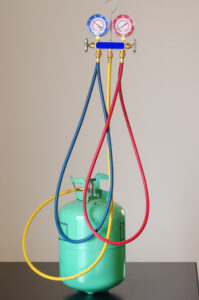In recent years, there has been a growing concern about the environmental impact of traditional refrigerants used in various cooling systems. As a response to this, researchers and industry professionals have been actively exploring alternative refrigerants that are more environmentally friendly. One such promising solution is A2L refrigerants, which are gaining attention for their lower global warming potential (GWP) and improved safety features.
Understanding A2L Refrigerants:
A2L refrigerants belong to the mildly flammable category, which is classified as lower risk compared to highly flammable options. The term “A2L” stands for “lower flammability” and is a designation given by ASHRAE (American Society of Heating, Refrigerating and Air-Conditioning Engineers) to refrigerants that exhibit a reduced risk of flammability compared to their more flammable counterparts.
Key Features and Benefits:

- Lower Global Warming Potential (GWP): A2L refrigerants are designed to have significantly lower GWP than traditional hydrofluorocarbons (HFCs) commonly used in refrigeration and air conditioning systems. This is crucial in addressing the environmental concerns associated with climate change, as these refrigerants contribute less to the greenhouse effect.
- Improved Energy Efficiency: A2L refrigerants often offer enhanced energy efficiency, contributing to reduced energy consumption in cooling systems. This can lead to lower operational costs for businesses and individuals while also aligning with global efforts to increase energy efficiency in various industries.
- Safety Considerations: While A2L refrigerants are mildly flammable, their flammability is considerably lower than other flammable alternatives. Manufacturers have implemented safety measures and design considerations to minimize risks, making A2L refrigerants a viable and safe option for various applications.
- Regulatory Compliance: A2L refrigerants align with evolving regulations and standards aimed at phasing out high-GWP refrigerants. Governments and international bodies are increasingly adopting policies that encourage the use of low-GWP alternatives, positioning A2L refrigerants as a compliant and responsible choice for the industry.
Applications and Industry Adoption:
A2L refrigerants are being integrated into various cooling applications, including residential and commercial air conditioning, refrigeration, and heat pump systems. Major players in the refrigeration and HVAC industry are actively researching, developing, and adopting A2L refrigerants to meet both environmental and regulatory requirements.
Challenges and Considerations:
Despite their numerous advantages, the adoption of A2L refrigerants is not without challenges. The industry must address concerns related to safety standards, code compliance, and building infrastructure modifications to ensure a smooth transition to these new refrigerants.
Conclusion:
As the world seeks sustainable solutions to combat climate change, A2L refrigerants emerge as a promising alternative to traditional high-GWP refrigerants. Their lower environmental impact, improved energy efficiency, and evolving safety features make them a crucial player in the ongoing efforts to create a more sustainable and responsible future for the refrigeration and air conditioning industry. As technology continues to advance, the widespread adoption of A2L refrigerants is likely to play a pivotal role in shaping the future of cooling systems worldwide.
Want more information about how the 410A phase-out or new A2L Refrigerants will impact you? Contact us TODAY!
